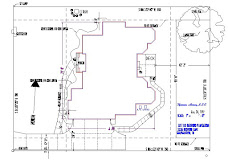Trim Materials:
Plan for your millwork package (see
Appendix E – Trim Order List) to be delivered at least two days
before the trim subcontractor is to begin, just in case there might
be a delay in shipping. Your trim man’s time is too valuable and
rigidly scheduled to risk not having materials on the job when he
arrives. You will lose his respect, and your job may suffer if he
leaves to begin someone else’s work instead. He will resent you, as
his other customer probably was told to hold on his millwork order,
and he will have to wait to begin that work.
 Photo
21: Built up fireplace surround by trim subcontractor, shown
unpainted under construction and finished product.
Photo
21: Built up fireplace surround by trim subcontractor, shown
unpainted under construction and finished product.We rarely lost any trim materials to theft, perhaps since the expensive items, like doors, are too difficult to haul and specially sized. Theft is therefore usually not a reason to worry and delay your order. The only materials your trim sub will furnish are nails and staples.
Before ordering meet with the millwork
company’s estimator after meeting with the trim sub, since you will
have a better idea of what is needed at that time. Your trim sub can
advise you on what to order for unusual items, like the scroll on a
mantel leg or built-in shelving. Be sure to get precise prices on
every piece of trim to be ordered before placing a purchase order.
Let the estimator prepare a written quote, and then edit your
purchase order to suit your own takeoff, since the supplier will over
estimate materials to be cautious, to prevent extra deliveries, or to
sell more product. Ask the cost of deliveries. We always got as many
free shipments as we needed, even for just one or two missing pieces,
since the millwork supplier had trucks making rounds daily just
shipping odd pieces.
An unscrupulous salesman we dealt with
once delayed faxing his quote, but gave an oral quote. We needed the
order right away and had to trust his word. When we received the
bill, it was a thousand dollars high. His boss assumed we were
bilking him, since we did not have written proof, and our working
relationship suffered as a result. Eventually the crooked salesman
was fired (probably for multiple complaints,) and we received a
credit, but we never recovered our reputation with the owner. Always
get your quote in writing.
Some items that may surprise you in
price include: flexible rubber molding for curved walls (some pieces
can exceed $18 per lineal foot), extra height doors, fiberglass
doors, or over sized wood veneer shelving (Photo 22.) Get accurate
written prices on everything before ordering. Another expensive piece
is a curved casing over an arched-top window. There are online videos
showing building some of the more intricate moldings from old
historic homes, duplicated with plaster molds and templates. If you
are handy and somewhat artistic, you might attempt to fabricate these
yourself, using a mold or a sculptured trowel. We had some trim men
who could fabricate specialty items at home from wood rather
inexpensively.
Ordering doors requires more detailed
specifications than most finish items (See Appendix E - ...Door
Schedule, & Door Hardware List.) We bought our doors from the
lumber company rather than the millwork supplier, because the
latter's were more expensive. A mystery to me at first was how to
tell the difference between a “left-hand” and “right-hand”
door swing. Our salesman had a silly but effective phrase to remember
which; he said, “It’s comin’ at cha.” This meant when you are
opening the door toward yourself, the side that the knob is on
determines the swing of the door. Opening your front door from the
inside with the knob in your left hand indicates a left-hand door.
Most of our doors were called
“six-panel” even if stamped from one piece of Masonite
hardboard. This is due to the original way doors were built with six
different beveled edge panels of wood joined together in a frame.
There are four-panel, solid slab, two-panel doors, and other
variations, but the six-panel doors we ordered were traditional and
seemed to never go out of style. Interior doors can be built of a
hollow-core frame, sandwiched between two hardboard faces, or they
could be built of more costly high-density fiber (HDF), or even more
expensive and non-environmentally correct wood. The wood doors are
more sound proof, but only truly so if weatherstripped, which is
impractical for interiors; thus specifying wood doors alone to
prevent sound transmission is ineffective. Exterior doors come in
many different configurations and materials. Fiberglass veneers over
a foam core are very weather resistant and durable, but they are more
costly than many other types and less secure. Metal clad foam core,
insulated doors are not attractive, but can serve for garage or rear
yard access and are inexpensive. Wood six-panel exterior doors are
attractive, but not weather resistant, and require more protection
and maintenance to prevent warping, splitting, and discoloration.


No comments:
Post a Comment